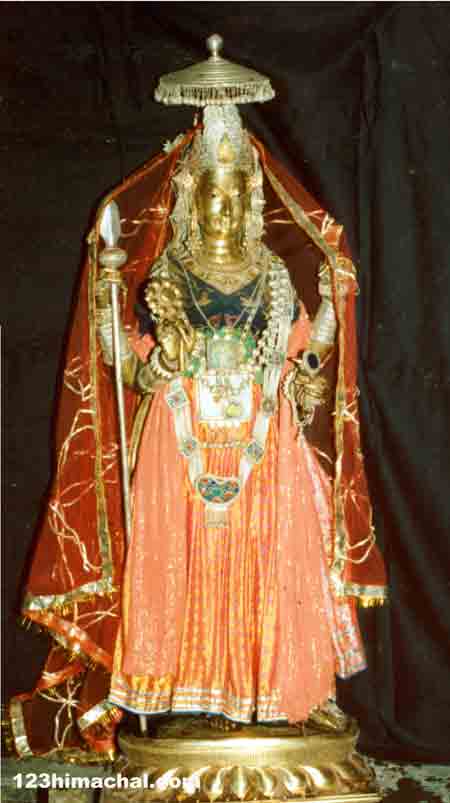|
 The
temple of Shakti Devi at Chhatrarhi belongs to the same period
as that of lakshana, is a good specimen of the Hill shrine described
above. The outer doorway, however, is evidently a later addition,
and the coarse frescoes on the walls of the cella are of quite
recent date. The ornamentation of the inner door-way is very similar
to that of the Lakshana Temple. Here also we find, over the
entrance, a row of flying figures --four on each side-the two in the
centre carrying a crown, whereas the remaining six are accompanied
by female figures each seated on the hip of its companion. Beneath
these there is a row of thirteen cross-legged figures, of which nine
represent the Nava-grahas, i.e, the Sun, the Moon, the five
planets-Mars, Mercury, Julpiter, Venus and Saturn-the eclipse-demon
Rahu and the comet Ketu. Rahu is represented by a demon's head
without a body, in agreement with the myth told in the Puranas. It
is said that Rahu stealthily partook of the nectar (amrita )
produced by the churning of the ocean, but was betrayed by the Sun
and the Moon, who had noticed the theft. He was beheaded by Vishnu,
but the head had become immortal by the use of the nectar. Since
then the Rahu head persecutes the Sun and the Moon and causes them
to eclipse. The four remaining figures at the two ends possibly
represent the Guardians of the Four Regions (Lokapalas). The
temple of Shakti Devi at Chhatrarhi belongs to the same period
as that of lakshana, is a good specimen of the Hill shrine described
above. The outer doorway, however, is evidently a later addition,
and the coarse frescoes on the walls of the cella are of quite
recent date. The ornamentation of the inner door-way is very similar
to that of the Lakshana Temple. Here also we find, over the
entrance, a row of flying figures --four on each side-the two in the
centre carrying a crown, whereas the remaining six are accompanied
by female figures each seated on the hip of its companion. Beneath
these there is a row of thirteen cross-legged figures, of which nine
represent the Nava-grahas, i.e, the Sun, the Moon, the five
planets-Mars, Mercury, Julpiter, Venus and Saturn-the eclipse-demon
Rahu and the comet Ketu. Rahu is represented by a demon's head
without a body, in agreement with the myth told in the Puranas. It
is said that Rahu stealthily partook of the nectar (amrita )
produced by the churning of the ocean, but was betrayed by the Sun
and the Moon, who had noticed the theft. He was beheaded by Vishnu,
but the head had become immortal by the use of the nectar. Since
then the Rahu head persecutes the Sun and the Moon and causes them
to eclipse. The four remaining figures at the two ends possibly
represent the Guardians of the Four Regions (Lokapalas).
Along the door-jambs we find a double row of standing figures on
each side of the entrance. Those of the two outer rows alternate
with crouching animal-headed figurines, which act as Atlantes, and
presumably are meant either for Rakshasas or for the Ganas of Shiva.
Among the standing figures we notice to the right the six-faced
Karttikeya with his peacock, and Indra the rain-god holding a
thunderbolt
( vajra ) and accompanied by his vehicle the elephant (Airavata ) ;
and to the left the four-armed Brahma, carrying a rosary and a
water-pot and accompanied by a pair of geese. The inner rows consist
each of four figures. On the left side we recognise Vishnu
three-faced, the side faces being a lion's and a boar's; and Durga
slaying the Buffalo-demon ( Mahishasura). The two lowermost figures
are again Gangla and Yamuna, the personifications of the sacred
rivers of India. In the upper corners of the door-way we notice the
same winged dragons as are found on the Lakshana temple.
The wooden pillars, with their pot-and-foliage capitals, supporting
elaborately carved bracket-capitals in which couchant bulls and
other animals have been introduced, deserve special notice. |

